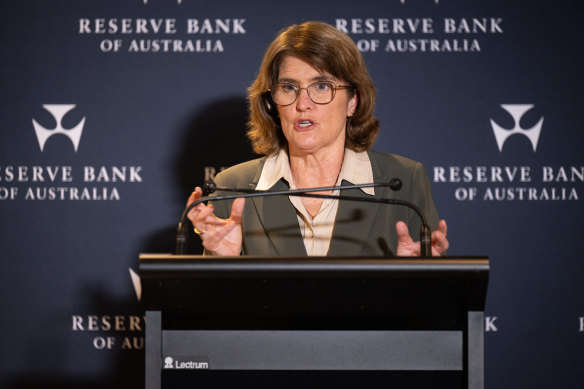Opinion
Memo to RBA: If wages growth isn’t the problem, then what is?
Ross Gittins
Economics EditorI can’t help wondering if the Reserve Bank isn’t misreading the economy. And it seems I’m not alone.
When you’re seeking to manage the economy through its ups and downs, it’s critically important to diagnose its problems correctly. If you’ve misread the symptoms, you can make things worse rather than better. Or, for instance, you can single out citizens who had the temerity to borrow heavily to buy their home and subject them to needless punishment.
Last week, several things made me start wondering if the Reserve needs a rethink. The first was a paper by America’s highly regarded Brookings Institution, that I should have got onto in August.

Michele Bullock is expected to keep rates on hold despite a drop in inflation.Credit: Louie Douvis
The world’s central banks – including ours – have concluded that this unexpected burst of inflation is explained partly by temporary disruption to the supply of goods caused by the pandemic (and Russia’s attack on Ukraine), and partly by excessive demand following the authorities’ excessive economic stimulus to counter the lockdowns.
Sorry, not true says the Brookings study, which looked at new data.
“The vast majority of the COVID-19 inflation surge is accounted for by supply-linked factors, especially a rise in company [profit] margins that followed severe delivery delays at the height of the pandemic. Demand-linked factors, notably indicators of labour market overheating, play almost no role.
“As a result, the argument that policy stimulus was excessive is weak,” the study says. And, since company profit margins have yet to return to their previous level, this suggests the inflation rate has yet to fall as the effects of the pandemic continue to unwind. If so, the US Federal Reserve may have overtightened.
Now, all that refers to the US economy and may not apply to ours. May not, but I doubt it.
Despite four successive quarters in which the economy’s rate of growth in “aggregate demand” has been very weak, our Reserve is delaying a reduction in interest rates because, it says, the level of demand is still higher than the level of supply. If so, the rate of inflation may not keep falling, or may even start rising.
How does the Reserve know the level of supply is too low? Mainly by looking at the measure of idle capacity in the jobs market – aka the rate of unemployment.
So, when we saw the figures for October last week, and they showed unemployment still stuck at an exceptionally low 4.1 per cent, no higher than it was in January, it wasn’t surprising that many concluded the Reserve wasn’t likely to start cutting the official interest rate until May next year.
But hang on. One good measure of the job market’s ability to supply more labour as required is the “participation rate” – the proportion of the working-age population willing to participate in the paid labour force by either having a job or actively seeking one.
Now, the econocrats have been predicting that the ageing of the population would cause the “part rate” to start falling for at least the past 20 years. But in that time, it has kept going up rather than down, and is now higher than ever. Last week’s figures show it’s risen by a strong 0.5 percentage points to 67.2 per cent over just the past year.
So where’s the evidence the economy’s reached the end of its capacity to supply more workers?
My guess is that all the Reserve’s unaccustomed talk about the level of supply being too low relative to demand is just a way for it to avoid admitting that its judgment about when to start cutting interest rates is still – as it has been for all macroeconomists for the past 40 years – heavily reliant on its calculation of the present NAIRU: the “non-accelerating-inflation rate of unemployment”, which is the lowest the unemployment rate can fall before shortages of labour cause wage inflation to start going back up.

Treasury secretary Dr Steven Kennedy.Credit: The Sydney Morning Herald
I think the Reserve’s reluctance to cut is driven by its (undisclosed) calculation that the NAIRU is well above 4.1 per cent. But earlier this month, Treasury secretary Dr Steven Kennedy told a parliamentary committee that, though such calculations are “uncertain”, Treasury estimates that the NAIRU is “around 4.25 per cent, close to the current rate of unemployment”.
Another thing we learnt last week was that a key measure of the rate at which wages are rising, the wage price index, rose by 0.8 per cent during the September quarter, causing the annual rate to fall from 4.1 per cent to 3.5 per cent.
According to Adam Boyton and other economists at the ANZ Bank, this caused the six-month annualised rate of wages growth to be unchanged at 3.2 per cent. “Wages growth has slowed across awards, enterprise bargaining agreements and individual agreements, pointing to a broad-based slowdown,” they said.
This – combined with the lack of increase in the rate of unemployment over the past year, and allowing for the delay before what’s happening to unemployment affects wage rates – has led these economists to conclude the NAIRU is closer to 3.75 per cent.
Finally, Westpac chief economist Dr Luci Ellis noted last week that another measure of wages pressure, the cost of labour per unit (which takes account of changes in the productivity of workers), has fallen from an annualised rate of 7 per cent to 3.5 per cent in just the six months to September.
She said that even if the annual improvement in the productivity of labour averages a touch below 1 per cent, which would be worse than our recent performance, annual wages growth averaging 3.2 per cent – as it has for the past three quarters – is “well and truly consistent with inflation averaging 2.5 per cent or below”.
Get what all this says? Ever since the Reserve began raising interest rates in May 2022, it has worried about the possibility of excessive growth in wages keeping inflation above the Reserve’s target zone. In all that time, and particularly now, it’s shown absolutely no sign of doing so. Neither shortages of labour nor the (much reduced) power of the unions have caused a problem.
The Reserve needs to lose its hang-up about wages and think harder about the need to ease the pain on innocent bystanders.
Ross Gittins is the economics editor.
Ross Gittins unpacks the economy in an exclusive subscriber-only newsletter. Sign up to receive it every Tuesday evening.